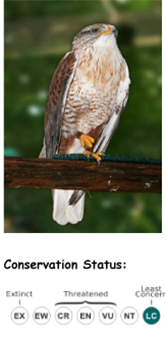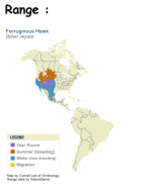Learn About Ferruginous Hawk
The Ferruginous Hawk (Buteo regalis) is a large, long-winged hawk of the open, arid grasslands, prairie and shrub steppe country. It is endemic to the interior parts of North America.
The word Ferruginous comes from the Latin name ferrum, meaning iron…therefore ferrgin- is for iron-rust color of the bird’s plumage.
This is the largest of the buteos and is often mistaken for an eagle due to its size, proportions and behavior. As with all birds of prey, the female is larger than the male. Length ranges from 51 to 66 cm, wingspan from 122 to 152 cm, and weight from 2.2 to 4.5 pounds (998 to 2,041 g).
Adults have long broad wings and a broad grey, rusty or white tail. The legs are feathered to the talons.
The preferred habitat for Ferruginous Hawks are the arid and semiarid grassland regions of North America. In Canada, this bird is mainly found in the Canadian prairies of Saskatchewan and Manitoba. These hawks avoid high elevations, forest interiors, narrow canyons, and cliff areas.
The Ferruginous Hawk primarily hunts small to medium-sized mammals (gophers, prairie dogs, squirrels, hares) but will also take birds (pheasants, grouses, ducks), reptiles (snakes), and some insects (grasshoppers, crickets, beetles). Mammals generally comprise 80 to 90 percent of the prey items or biomass in the diet. The diet varies somewhat geographically, depending upon the distribution of certain prey species.
During the breeding season, the preference is for grasslands, sage, and other arid shrub country. Nesting occurs in the open areas or in trees including cottonwoods, willows, and swamp oaks along waterways.
The nests are built on the ground and made of ground debris such as sticks, branches, and cattails. Old nests will be refurbished, or nests of other species may be taken over and refurbished with sticks being added on top of the old nests. Odd items such as paper, rubbish, barbed wire, cornstalks, plastic and steel cable have been incorporated into nests. Bark from trees and shrubs will be used for lining along with grasses and cow dung; historically, buffalo dung was used.
In the Canadian parts of the range, laying occurs during the latter part of April through late June.
Egg-laying occurs at two-day intervals with incubation starting when the first egg is laid. Incubation is shared by both sexes with each taking approximately the same number of shifts during the 32 day average incubation period.
Clutch size varies from one to eight and is likely linked to food supply. The average clutch is three to four eggs.
Birds have been known to live for 20 years in the wild, but most birds probably die within the first five years.
The reasons for mortality include illegal shooting, loss of a satisfactory food supply, harassment, predation, and starvation of nestlings during times of low food supply. Ground nests are susceptible to predation by coyotes, and nestlings may be preyed upon by great horned owls and golden eagles.
At times the Ferruginous Hawk has been considered threatened, endangered, or of concern on various threatened species lists but recent population increases in local areas, coupled with conservation initiatives, have created some optimism about the bird’s future. It was formerly classified as a Near Threatened species by the IUCN, but new research has confirmed that the Ferrugineous Hawk is common and widespread again. Consequently, it is downlisted to Least Concern status in 2008.
Declines are mostly due to loss of quality habitat, cultivation of native prairie grassland and subsequent habitat loss, tree invasion of northern grassland habitats, reductions in food supply due to agricultural pest management programs and shooting and human interference.
Obviously, public education and the elimination of persecution and human disturbance must be an important part of the overall conservation program.

Scientific Classification:
- Kingdom: Animalia
- Phylum: Chordata
- Class: Aves
- Order: Falconiformes
- Family: Accipitridae
- Genus: Buteo
- Species: B. regalis

References: Part of this article incorporates text from the Bureau of Land Management, which is in the public domain. * BirdLife International (BLI) (2004). Buteo regalis. 2006 IUCN Red List of Threatened Species. IUCN 2006. Retrieved on 11 May 2006. Database entry includes a brief justification of why this species is near threatened * BirdLife International (BLI) (2008): [2008 IUCN Redlist status changes]. Retrieved 2008-MAY-23. * Cartron, J.L.E.; Polechla, P.J. & Cook, R.R. (2004): Prey of nesting Ferruginous Hawks in New Mexico. Southwestern Naturalist 49(2): 270-276. * Littlejohn, Chase (1916): Some unusual records for San Mateo County, California. Abstract in: Cooper Club: Minutes of Cooper Club Meetings. Condor 18(1): 38-40.

